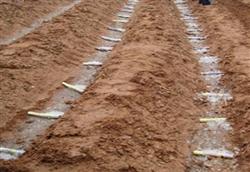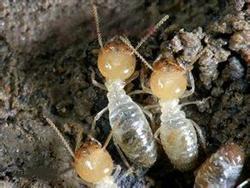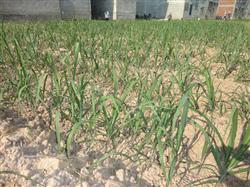How to cultivate water-saving sugarcane in winter and spring

Paddy sugarcane is one of the important types of sugarcane cultivation in Yunnan. Many sugarcane cultivation areas in our province have serious soil erosion, irrigation and water conservancy facilities construction lags behind, coupled with drought and lack of rain in winter and spring, paddy fields are short of water. Except that some fields can plant sugarcane in accordance with the requirements of the festival, most of the paddy fields are planted late, and they are not planted until the end of April to the first ten days of May. It seriously affects the yield, sugar content and benefit of sugarcane in paddy field. In recent years, according to the climate characteristics of Yunnan Province, the relevant departments of Yunnan Province have made great efforts to reform the planting system and explore the water-saving planting technology of sugarcane, which has achieved remarkable results. practice has proved that by using this technology to plant sugarcane, the average yield of sugarcane is 1.5 million tons per mu and the sugar content is increased by 0.4% to 0.6%. The main points of this technology are as follows: soil preparation, deep ploughing, fine raking and fine rake to achieve "deep, loose, fine and flat". Dig irrigation ditches around, generally the bottom of the ditch is about 40 cm wide and the ditch depth is 40-50 cm, depending on the size of the field; if the field is too large, add "cross" or "well" trench to ensure that drought and rain can be drained. The row spacing of sugarcane ditch is between 90cm and 100cm, and the depth of sugarcane ditch is generally 30cm and 35cm. After digging into the plate soil, before planting, the plate soil with a depth of 4cm and 5cm is crushed as cover soil. The key to high and stable yield is to select improved varieties which are suitable for local natural conditions, such as no miscellaneous, no lodging and no diseases and insect pests. Drought-resistant and barren-tolerant varieties such as Liangyu 97Wei18, Chuanzhe 79x15, NTSC 22, 20 and Yuezhe 86x368 can be selected. Pay attention to plant selection during seed cutting and seed treatment, and select sugarcane with no hybrid, no diseases and insect pests, uniform cane and full buds. The knife used for seed cutting should be thin and sharp, and the sugarcane should be cut into a cross section as far as possible, not into a slope, and cut off with one knife, so as to reduce the rupture of the cut and the surface of the wound, reduce the infiltration surface of bacteria, and take the double teeth as a section. The seeds are treated with conditional plots, the seed pool is dug, the bottom and periphery of the pool are sealed with plastic film, and the seeds are soaked in 2%-3% lime water for 24 hours. Where it is inconvenient to get water, 5% to 8% of the lime water can be put into the plastic bucket, and then all the sugarcane seeds can be inserted or cut into the mouth for disinfection to prevent red rot and Phoenix plough disease. Timely sowing is generally appropriate from the middle of January to the middle of February. To determine the amount of seed, the number of buds per mu is 7500 to 8500 buds. In the next way, the "triangle" is the best way, about 1.5 inches away from both sides of the sugarcane ditch. The principle of applying base fertilizer is mainly mature farm manure (1000 kg / mu), supplemented by chemical fertilizer, 15 kg of urea, 50 kg of calcium, 10 kg of potassium chloride, 3 kg of Diachongling, and evenly applied to sugarcane ditch. Watering, ditch cleaning, soil cover, grass sealing and plastic film mulching are generally determined according to the full moisture absorption of farm manure applied into sugarcane ditch and slightly water leaching, using 20 to 30 piculs of water per mu, watering one ditch to cover one ditch, increasing water and preserving soil moisture, promoting the early growth and rapid development of sugarcane and strong seedlings. Clear ditch cover soil the first planting sugarcane ditch, fertilization, application, watering, clean the second ditch wet fine soil to cover the first sugarcane planting ditch, generally cover 1.5 inches of sugarcane seed, and then press the plate, and the soil is covered into a convex tile type. Seal the grass with 40% atrazine 200 ml and 60 kg of water and spray it evenly on the surface of the sugarcane ditch. The covering film is covered with 40 cm wide plastic film, which requires compaction around, fully expand the light transmittance of the middle part, increase the ground temperature and speed up germination. Mid-tillage management enters the rainy season from the end of May to June, which is the critical period for sugarcane production management. We must seize the season and grasp the following measures in accordance with the requirements of sugarcane production management of "double high": timely uncover the film from the end of April to the beginning of May, with the continuous rise of temperature, sugarcane enters the middle tillering stage, it is necessary to timely uncover the film before the rainy season, and concentrate on collecting the waste plastic film. Applying seedling fertilizer in time, promoting tillering and strengthening seedlings, promoting the combination of control, controlling sugarcane turtles and borer, reducing the mortality rate, using urea 20 kg, common calcium 30 kg per mu, adding appropriate amount of sugarcane special insecticides were applied to the base of sugarcane seedlings, and small soil cultivation and grass sealing were carried out. The thickness of soil cultivation depends on the target yield of basic seedlings. If the number of seedlings has reached the target, it should be higher, control ineffective tillers, and cultivate strong seedlings; if it does not reach the target, it is appropriate to just cover the fertilizer to promote the development of tillers and improve fertilizer use efficiency and stem formation rate. The key period of high and stable yield of sugarcane is to re-apply stem fertilizer and cultivate soil to prevent sugarcane from lodging from June to July, which is also the period when sugarcane needs the most fertilizer and water and produces the fastest. As the rainy season in a small part of our province is concentrated in June, July and August, it is necessary to strengthen ditch cleaning, drainage, weeding and removal of foot leaves to prevent stagnant water and improve ventilation and light transmission conditions to ensure the healthy growth of sugarcane. In sunny days, urea 30kg / mu, calcium 50kg / mu and potash fertilizer 10kg / mu were mixed and applied to the base of sugarcane seedlings, and high soil cultivation was carried out. After uncovering the film, applying seedling fertilizer and cultivating soil, 40% atrazine 200 ml 250 ml water 40 kg per mu was sprayed to control weeds in sugarcane ditch. For the plots that are not blocked and the weeds are too large, use 20 g Wutram 150 ml, add atrazine 150 ml with water 50 kg to seal the sugarcane line, choose sunny day spray, be careful not to spray to the sugarcane leaves and the base of sugarcane, so as to avoid drug damage. Leaf pest control from June to October, the main pests harmful to sugarcane leaf pests are thrips, cotton aphids, and so on. In order to eliminate the hair center of sugarcane field in time, insecticidal pesticides such as 20% Libaodan EC or 48% Lesbon EC or 40% omethoate can be sprayed with 1500-2000 times of water, and the spraying should be thoughtful and meticulous, leaving no dead corners. The most common diseases in many sugarcane areas are sugarcane brown stripe disease and rust. Prevention and control measures: first, to eliminate waterlogging in the field, to remove withered and yellow foot leaves and weeds, so as to make the perimeter of sugarcane ventilated and transparent; second, to appropriately reduce the amount of nitrogen fertilizer and increase the application of phosphorus and potassium fertilizer. Third, for the seriously affected plots, pesticide control should be used. 50% carbendazim or 75% chlorothalonil or 65% Dysen zinc or 12.5% uniconazole 500 times per mu should be sprayed in the afternoon on a sunny day, once every 7 days or so. 2 times in a row. When harvesting at the right time and paying attention to protecting the head of sugarcane, a small hoe should be used to quickly hoe and cut low at 3-5 cm below the sugarcane soil surface, so as to avoid using incorrect sugarcane cutting methods to split sugarcane stakes and damage sugarcane buds, so as to ensure the germination of low lateral buds and lay a good foundation for next season production.
- Prev

Harm and control methods of sugarcane termites
Sugarcane termites are mainly black-winged termites and yellow-winged termites. Sugarcane will be harmed by termites in the whole growing period, especially in the germination stage after sowing, and the harmful sugarcane species often invade through the incisions at both ends and eat the tissue in the stem, so that the seedlings can not germinate. In the middle and later stage, it was eaten by the underground sugarcane, making the stem hollow, the leaves withered yellow or dry shoots, and the whole plant withered.
- Next

Interplanting technique of Spring Peanut and Sugarcane
Sugarcane is native to tropical and subtropical areas and was previously planted only in the south of the Yangtze River. In recent years, through the unremitting efforts of scientific and technological workers, the planting area of sugarcane in the Huang-Huai River Basin has expanded year by year. In the process of planting, the stem of sugarcane can not be used to raise buds at high temperature. if the stem is used to raise buds, sugarcane will not be cultivated successfully. Yes.
Related
- Moge, come on! The staff of the peasant association in the producing area of cantaloupe were frightened when the crowd gathered.
- Causes and Solutions of low Fruit setting rate of Apple
- Symptoms and control measures of passion fruit virus disease
- Fruit growing lesson: how do apple orchards keep high yields?
- Can you build orchards in the mountains? What are the pros and cons?
- How to manage the coloring period of Crisson grape?
- This paper introduces the processing technology of two kinds of fig products.
- How much is a month for retired teachers in rural areas by 2020?
- How can strawberry planting increase sugar content? We should pay attention to management in many aspects.
- What are the cultivation techniques on how to improve the yield of golden fruit?

